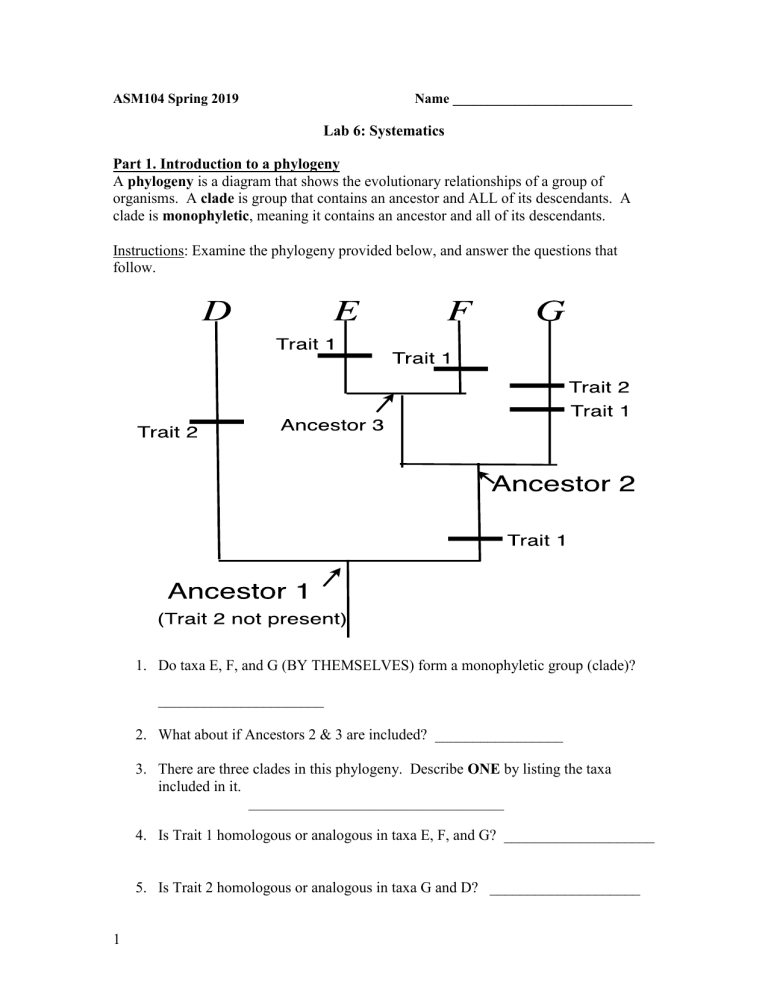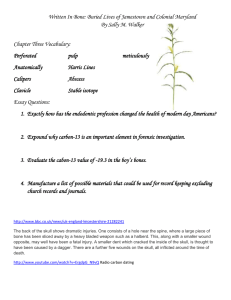
ASM104 Spring 2019 Name __________________________ Lab 6: Systematics Part 1. Introduction to a phylogeny A phylogeny is a diagram that shows the evolutionary relationships of a group of organisms. A clade is group that contains an ancestor and ALL of its descendants. A clade is monophyletic, meaning it contains an ancestor and all of its descendants. Instructions: Examine the phylogeny provided below, and answer the questions that follow. 1. Do taxa E, F, and G (BY THEMSELVES) form a monophyletic group (clade)? ______________________ 2. What about if Ancestors 2 & 3 are included? _________________ 3. There are three clades in this phylogeny. Describe ONE by listing the taxa included in it. _____________________________________ 4. Is Trait 1 homologous or analogous in taxa E, F, and G? ____________________ 5. Is Trait 2 homologous or analogous in taxa G and D? ____________________ 1 Part 2. Creating a phylogeny Instructions: Using the information on character states given in Table 1, fill in the blanks on the phylogeny. Be sure to answer the questions that follow. Table 1: Vertebrate characteristics Trait Lobefinned fish Frog Turtle Kangaroo Mouse Human Backbone Yes Yes Yes Yes Yes Yes Legs No Yes Yes Yes Yes Yes Outside mother Outside mother Outside mother Inside mother Inside mother Inside mother Hair No No No Yes Yes Yes Presence of pouch No No No Yes No No Presence of tail in adult Yes No Yes Yes Yes No Place fetus develops 2 1. Are any of the traits unique AND derived for a particular species? If so, which trait and which species? 2. What is a derived trait shared by kangaroos, mice, and humans only? 3. Is lack of a tail homologous or analogous for the frog and the human? 4. The presence of a backbone is an example of which kind of trait for all the species on the phylogeny? Part 3. Determining character states: an introduction to primate systematics Instructions: Compare the six labeled skulls and fill in the chart by assigning character states to the characters using 0, 1, or 2. Then, use the information from the completed chart to answer the following questions. Score the characters in the following manner: Post-orbital bar: 0 = absent 1 = present Post-orbital closure: 0 = absent 1 = present Tooth comb: 0 = absent 1 = present Dental formula: 0 = 2.1.3.3. 1 = 2.1.2.3. 2 = other Position of foramen magnum: 0 = back of skull 1 = bottom of skull Table 2: characteristics Skull A Skull B Skull C Skull D Skull E Skull F Post-orbital bar Post-orbital closure Tooth comb Dental formula Position of foramen magnum 1. Skulls B, C, D, E, and F are primates. Which character state is a shared derived feature for all primates (i.e., which character state do all primates share)? Note: All primates living and extinct have this feature. 3 2. Skull B is a strepsirhine primate. Skulls C, D, E, and F are haplorhine primates. Which two character states differ between haplorhine and strepsirhine primates? 3. Skull C is a platyrrhine primate, and skulls D, E, and F are catarrhine primates. What character state differs between platyrrhines and catarrhines? 4. Skull F is from a type of catarrhine known as a hominin. What character state is unique and derived for skull F? Part 4. Classification There are two components to systematics: phylogeny reconstruction and classification. Classification refers to how we organize our information about creatures. It is possible to organize creatures in many ways- it depends on what information the biologist thinks is most important to convey. In lecture, you learned about two methods of classification: cladistics and evolutionary systematics. Answer the following questions that differentiate between the two methods: 1. What is the primary information conveyed in a cladistic classification? 2. What type of trait is used to generate a cladistic classification? 3. What types of information are conveyed in an evolutionary systematics classification? 4. What three types of traits are used to generate an evolutionary systematics classification? 4
